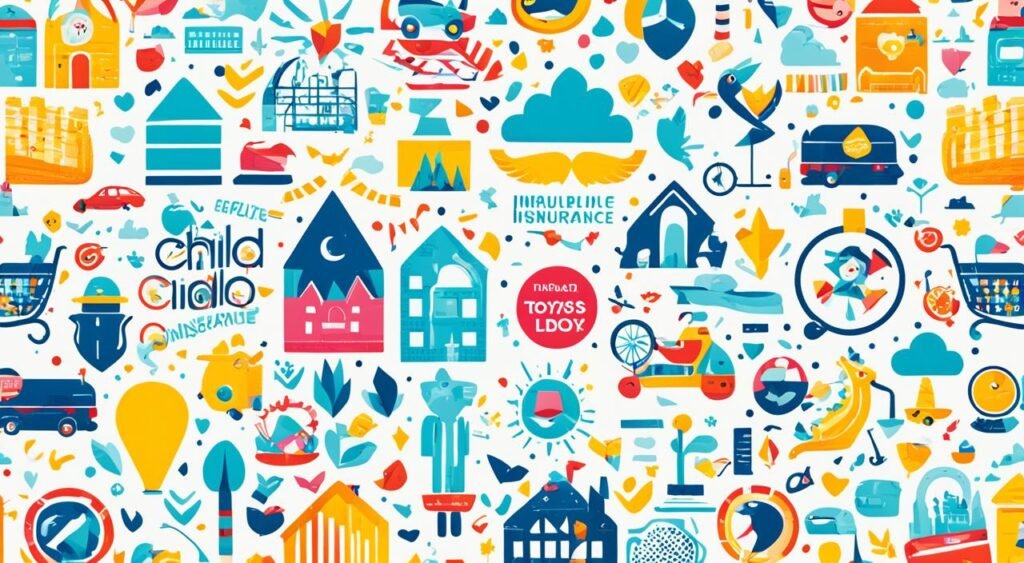Life insurance for kids is a special type of insurance that covers a child’s life. It works differently from adult’s life insurance. It protects a child’s future and brings benefits that are useful when they grow up. It can be bought by itself or added to a parent’s or guardian’s policy. This gives peace of mind and security for the child’s future.
Key Takeaways
- Children’s life insurance can be purchased as a standalone whole life policy or as a rider to a parent’s life insurance.
- The main benefits of child life insurance include guaranteed insurability, locked-in low rates, and funds for funeral expenses.
- Children’s life insurance policies typically have lower coverage limits, usually less than $50,000.
- Purchasing life insurance for a child can make it easier and more affordable for them to maintain coverage as an adult.
- Factors to consider when buying life insurance for a child include family medical history, the child’s income and responsibilities, and the provider’s reputation.
Understanding Life Insurance for Children
Life insurance for children is a special financial tool designed for kids. It offers long-term benefits and coverage. These policies are different from those for adults. Parents and guardians need to know how they work.
What Is Life Insurance for a Child?
Children’s life insurance is a type of permanent policy. It gives a set benefit if the child covered passes away. It also works as a way to save money. These policies grow in value over time.
Types of Life Insurance for Children
- Standalone Whole Life Policy: A life insurance just for the child, available from birth up to age 18.
- Child Life Insurance Rider: This adds coverage to existing policies of parents or guardians.
Most children can get life insurance by the time they are two weeks old. The age limit depends on the insurance company, ranging up to 17 or 18 years old. At a certain age, usually between 18-25, the child can take ownership of the policy.
Also Read: How To Get Financial Aid For University Of Houston
| Life Insurance Type | Coverage for Children | Ownership Transfer |
|---|---|---|
| Standalone Whole Life | Dedicated policy for the child | 18-25 years old |
| Child Life Insurance Rider | Added to parent/guardian’s policy | 18-25 years old |
Choosing the right life insurance for a child is based on the family’s needs. It considers the family budget and what the child needs. Both standalone and rider options have benefits worth looking at.
Benefits of Buying Life Insurance for Kids
Getting life insurance for your child has many benefits. It’s more than coverage if they pass away. It helps ensure they can get insurance later, even if they’re sick or in a risky job. It also locks in low prices for their insurance, making it a smart move.
Guaranteed Insurability
A child life insurance policy guarantees they can get insurance later on. It means they won’t be denied or face high costs, even if they’re very sick or work a risky job. This security really helps parents relax.
Locked-In Low Rates
Buying insurance for your child now means getting cheaper prices. As they grow, the cost goes up. So, save money by getting their policy early.
Also Read: What Documents Are Needed To File A Car Insurance Claim?
Funds for Funeral Expenses
If the worst happens and your child passes, a policy can help pay for their funeral. It also lets the family take time off to grieve. Even with smaller amounts, under $50,000, it can be a big help when you need it most.
| Benefit | Description |
|---|---|
| Guaranteed Insurability | Ensures your child can obtain coverage in the future, even with pre-existing conditions or high-risk occupations. |
| Locked-In Low Rates | Securing a policy at a young age allows you to lock in lower premium rates compared to purchasing coverage later in life. |
| Funds for Funeral Expenses | The death benefit can help cover the costs of a child’s funeral and provide the family with time off work to grieve. |
Learning about all the benefits of child life insurance helps parents make a smart choice. It’s about protecting their family’s future and giving their children the safety they need.
Cash Value Growth Potential

Whole life insurance policies for children offer a great benefit known as the cash value. The cash value grows over time at a fixed rate. It can be used for things like a child’s education or a home down payment.
This savings part has tax-advantaged growth, which is a plus.
But, remember, taking money out or borrowing from it will decrease the death benefit. And, its rate of return is usually less than investments like a 529 plan.
It’s key to understand how the cash value works in life insurance for children. Though the tax-advantaged growth is attractive, consider the possible lower returns with other savings options.
Also Read: What Is Flood Insurance And What Does It Cover?
“The cash value component in a child life insurance policy can be a valuable savings tool, but it’s important to understand the trade-offs involved.”
Drawbacks of Life Insurance for Kids
When considering child life insurance, remember there are some downsides. A key issue is that the cash value part doesn’t grow much. Investments like the 529 college plan tend to offer better returns. So, families focused on their child’s financial future might find better options elsewhere.
One drawback is the need to keep paying for many years. This might not work well if your money situation changes. If you stop the policy, you might lose the money you’ve already spent on it.
Low Rate of Return
The cash value doesn’t grow fast with child life insurance. It often performs lower than other saving options like 529 college savings plans. So, the returns might not be as good as with a different kind of savings account.
Long-Term Commitment
With life insurance for kids, you’ll need to keep paying for a long time. This can become a heavy financial burden if your situation gets tougher. Cancelling the policy might lead to loss of the money you’ve paid in.
Also Read: What Are The Benefits Of Having A Life Insurance Policy?
Due to these factors, watch out before choosing life insurance for kids. It might not be the ideal pick, especially if you’re aiming to save for the future. Think carefully about what’s best for your family and its long-term money plans before buying a child life insurance policy.
life insurance for kids

When you think about life insurance for kids, start by looking at how much coverage you need and what it costs. These policies usually cover from $5,000 to $50,000, but some go up to $100,000. The good news is these policies cost less than what adults pay. For example, a $25,000 whole life policy for a new baby avg. about $14 a month.
Several things can affect a child’s insurance cost. They include:
- The amount of coverage desired (higher coverage amounts typically result in higher premiums)
- The type of policy, such as term life insurance or whole life insurance
- The payment schedule, whether the policy is paid off over a fixed period (e.g., 10 or 20 years) or throughout the child’s lifetime
When you look at a child’s life insurance cost, think beyond the starting price. It’s key to see the long-term value and what benefits the policy brings. Some plans cost more at first but have perks like cash value growth or guaranteed insurability later on.
| Coverage Amount | Average Monthly Premium (Whole Life) | Average Monthly Premium (Term Life) |
|---|---|---|
| $25,000 | $14 | $7 |
| $50,000 | $28 | $14 |
| $100,000 | $56 | $28 |
By understanding the coverage amounts and associated policy costs, parents can pick the best life insurance for kids. It should meet their needs and fit their budget.
Also Read: The Role Of Technology In University Campus Safety
When to Buy Life Insurance for a Child
Finding the right time to buy life insurance for a child is important. Kids can get life insurance as early as 14 or 15 days old. But the age when they can get a policy varies among insurers, going up to 25 years old. Remember, getting insurance early means you might pay less for it over time.
Eligibility and Age Limits
Deciding if your child is eligible for life insurance involves thinking about their age. Usually, kids from just two weeks old up to 25 years old can be covered. This wide age range lets parents pick a plan that fits their family and budget.
It’s also smart to think ahead about insurable interest. If health conditions run in the family or your child might choose a risky job, early insurance can lock in cheaper rates. This way, they could have protection even if they face these issues later on.
But, deciding to buy a policy for your child is a big choice. Think about your family’s money situation and goals. Look at the pros and cons, like how long you’ll pay and the low chance of using the policy. This helps make sure it’s a good fit for your financial plan.
“Investing in a child’s future through life insurance can provide valuable financial protection and peace of mind for parents.”
How to Purchase a Child Life Insurance Policy
Getting life insurance for your child is smart. It offers good financial protection and peace of mind. Buying a child life insurance policy is usually easy. Parents, grandparents, or legal guardians can get coverage simply. Let’s look at the main steps involved.
Connecting with Insurance Providers
Start by talking to insurance companies. You can check out their websites for quotes. Or, speak with a licensed insurance agent. Filling out the needed paperwork can be done online or by phone.
Gathering Required Information
You’ll need to give some basic info about your child. This includes their name, date of birth, and Social Security number. Usually, there’s no need for the child to have a medical exam.
Policy Ownership Transfer
Child life insurance has a cool feature. Policy ownership can be moved from the parent or guardian to the child later on. This happens when the child turns 18 to 25. It lets the child manage and protect their own policy as they grow.
By knowing the easy steps to buy, adults can make sure the kids they care about are financially safe. This step is a great way to give long-lasting protection and benefits to the family.
| Key Steps in Purchasing Child Life Insurance |
|---|
|
“Investing in a child’s life insurance policy can be a wise decision, providing financial protection and future security for the entire family.”
Don’t forget, buying child life insurance is meant to be clear and easy. It helps make sure your kid’s finances are safe.
Key Considerations for Child Life Insurance

Thinking about life insurance for your child? You should look at your family’s health history and if your child will need to support the family in the future. These are the big things to consider.
Family Medical History
If your family has a history of genetic or chronic diseases, getting life insurance for your child early is wise. It ensures they won’t be denied coverage later or have to pay more because of past health issues.
Child’s Income and Responsibilities
Is your child helping out at home financially now or will they in the future? If so, life insurance can be important. It protects your family’s finances if something happens to your child.
But, think about your other saving and investing options too. A 529 college savings plan might be better if your main goal is the child’s education. Adding a child rider to your life insurance could also be a smart choice. It might be cheaper than a separate plan for the child.
| Consideration | Key Points |
|---|---|
| Family Medical History |
|
| Child’s Income and Responsibilities |
|
Considering these points carefully will help you make a good choice about child life insurance. Look at what your family needs and your financial goals.
Popular Child Life Insurance Providers

Several big insurance companies offer life insurance for children. These include Aflac, American Family, Foresters, Gerber Life, Globe Life, and Mutual of Omaha. They each have special whole life insurance for young people.
Aflac has the Aflac Juvenile Whole Life Insurance, with coverage from $5,000 to $30,000. American Family provides a policy for kids up to 18 years old, up to $50,000. Foresters offers the Advantage Plus plan from $10,000 to $100,000.
Gerber Life has the famous Gerber Grow-Up Plan starting at $5,000. Globe Life offers coverage from $5,000 to $30,000. Then, Mutual of Omaha’s policy goes up to $50,000 for kids between 14 days and 17 years old.
Parents can get online quotes and apply for these insurances directly. Some may require talking to an insurance agent first. All these plans support guaranteed insurability, low rates, and help with funeral costs. These are key benefits for family financial safety.
| Provider | Policy Name | Coverage Amounts | Eligibility Ages |
|---|---|---|---|
| Aflac | Aflac Juvenile Whole Life Insurance | $5,000 – $30,000 | – |
| American Family | Children’s Whole Life Insurance | Up to $50,000 | 14 days – 18 years |
| Foresters | Advantage Plus Whole Life Insurance | $10,000 – $100,000 | – |
| Gerber Life | Gerber Grow-Up Plan | Starting at $5,000 | – |
| Globe Life | Juvenile Whole Life Insurance | $5,000 – $30,000 | – |
| Mutual of Omaha | Children’s Whole Life Insurance | Up to $50,000 | 14 days – 17 years |
These providers have diverse plans to fit every family’s needs. By knowing about each plan’s benefits, parents can choose wisely. This helps in protecting their children in the future.
Alternatives to Child Life Insurance
Think about what’s best for your child’s financial future. A life insurance policy for your child can offer protection. Yet, there are other choices to look into that might better meet your needs and goals.
Adding a Child Rider
Instead of a separate child life insurance, consider adding a child rider to your policy. This offers coverage if your child passes at a lower cost than a separate policy. It’s often more affordable and flexible for your family’s insurance needs.
Investment and Savings Options
You can also save for your child’s future in different ways. Look into a 529 college savings plan, mutual funds, or traditional bank accounts. These might give better returns and fit your financial goals better.
- 529 college savings plan: A tax-advantaged way to save for college costs.
- Mutual funds: They are pools of money used to buy diverse investments, managed by professionals.
- Bank accounts: Good for keeping your child’s money safe, but usually less profit than investments.
Choosing the right option apart from child life insurance is vital. Think about your family’s needs, goals, and how much risk you’re willing to take. By looking into these choices, you can ensure your child’s future financial health while aiming for growth and flexibility. best life insurance for children buy additional standalone life insurance policies term and whole life insurance.
Also Read: What Are The Benefits Of Term Life Insurance And How Are Premiums Calculated?
Conclusion
Life insurance for children offers some key perks like the ability to lock in low rates and having cash for funerals. Yet, it also comes with cons, such as not the best cash return and requires a long financial commitment. Before getting life insurance for your child, think about your family’s specific needs and goals.
There are other options to consider, like adding a rider to your policy or looking into different savings and investment plans. The choice to insure your child should involve deep thought, considering your family’s future and what is best for them.
When weighing life insurance for kids, remember the upsides like guaranteed insurability and locked-in low rates. But also keep in mind the downsides, such as the low cash return and commitment needed. It’s important to think about your family’s needs and financial goals before deciding on life insurance.
FAQs
Q: What is life insurance for kids and what are the benefits?
A: Life insurance for kids is a type of policy that provides financial protection in case the child passes away. The benefits include covering funeral expenses, offering financial security for the family, and potentially building cash value over time.
Q: How does life insurance for children work?
A: Life insurance for children functions similarly to adult policies, but with lower coverage amounts. It can be a whole life policy that builds cash value or a term policy that provides coverage for a specific period.
Q: What are some of the best life insurance companies for children?
A: Some of the top life insurance companies for children include Gerber Life Grow-Up, American Family Life, and others that offer whole life coverage specifically tailored for kids.
Q: What are the cons of buying life insurance for children?
A: The drawbacks of purchasing life insurance for children include the cost of premiums over time, the possibility of not needing the coverage, and the fact that children are less likely to face medical underwriting issues.
Q: Is whole life insurance a good option for children?
A: Whole life insurance can be a good choice for children as it provides permanent coverage, builds cash value over time, and can be a gift that grows in value as the child gets older.
Q: What factors influence the cost of life insurance for children?
A: The cost of life insurance for children is influenced by factors such as the child’s age, health status, coverage amount, type of policy (whole or term), and the insurance company’s rates.
Q: Should parents consider buying life insurance for their children?
A: It is a personal decision for parents to consider buying life insurance for their children. Factors like financial stability, future needs, and long-term planning should be taken into account before making a decision.
Source Links
- https://www.forbes.com/advisor/life-insurance/life-insurance-for-children/
- https://www.nerdwallet.com/article/insurance/should-you-buy-life-insurance-for-children
- https://www.usnews.com/insurance/life-insurance/life-insurance-for-children





